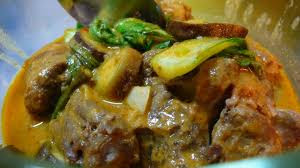Dinuguan (also called dinardaraan in Ilocano, tid-tad in Pampanga, sinunggaok or champene in Batangas, and sampayna or champayna in Northern Mindanao. Possible English translations include pork blood stew, blood pudding stew, and chocolate meat) is a Filipino savory stew of meat and/or offal (typically stomach, intestines, ears, heart and snout) simmered in a rich, spicy dark gravy of pig blood, garlic, chili (most often siling mahaba), and vinegar. The term dinuguan comes from the Filipino word dugo meaning "blood".
It is frequently considered an unusual or alarming dish to most people, though it is rather similar to European-style blood sausage, or British black pudding in a saucy stew form. It is perhaps closer in appearance and preparation to the Polish soup Czernina or an even more ancient Spartan dish known as melas zomos (black soup) whose primary ingredients were pork, vinegar and blood.
Dinuguan can also be served without using any offal, using only choice cuts of pork. In Batangas, this version is known as sinunggaok. It can also be made from beef and chicken meat, the latter being known as dinuguang manok ('chicken dinuguan'). Dinuguan is usually served with white rice or a Philippine rice cake called puto.
Cooking Dinuguan
Ingredients
You won’t find most of these ingredients at your local Pathmark or Albertson’s. Queue up your yellow pages and look for an Asian market.
1 lb. pork meat
2 cups pork blood
1 onion
1 pack laurel leaves
6 peppers (the small, hot, green ones)
1 tbsp salt
1 tbsp olive oil
1 ground pepper
1 garlic clove
Preparation
Have two pots for this. One of your pots (the pork pot) should be for the pork. The other pot (the main pot) will bear the brunt of the cooking. You will use the main pot to simmer the blood, so it will be heavily stained.
The blood takes the longest to prepare. Most likely, your blood will be frozen when you buy it. Thaw it until it becomes liquid again. DO NOT cook it when it is still in its frozen state! Doing so will introduce unwanted water into the simmer and some bacteria may survive the simmer.
COOKING PROCESS
As the blood is thawing, mince 1 garlic clove and set aside.
Slice the onion and set it aside as well.
What you do with the peppers is up to you. You can leave them as they are or slice them.
Take your main pot, put in the olive oil, and heat it.
Once the oil is hot enough, place the minced garlic, onions, and peppers.
After 2 minutes, pour in the blood. Add salt and pepper, and let it simmer for perhaps 1 to 1½ hours.
Slice the pork meat into bite-sized pieces.
After you slice them, you can exercise what little freedom you have with this recipe. You can cook the pork however you want, as long as it is rare and tender when it enters the main pot. Personally, I add about 3 cups of water and boil the pork for 1 hour. This is the healthy way of preparing pork.
Once the blood starts boiling nicely and the pork gets nice and tender, mix the ingredients.
Mix the pork (without the water, of course) into the blood and cook for another 30 minutes.
Diniguan goes well with steamed white rice. This particular recipe makes six servings.
Nutrition-wise, expect semi-clogged arteries and an expanded belly. Diniguan is only served on special occasions for a good reason.
Let’s eat!
Experience the tastes and colors of Philippine food. A gastronomic delight that has been savored through many generations.
references:
http://en.wikipedia.org/wiki/Dinuguan
 Ginataang Manok means chicken stewed in coconut milk. This is a simple Filipino dish wherein chicken is sautéed in garlic, onion, and ginger then stewed in coconut milk. A more traditional approach requires native hen (usually grown in the backyard). It is much tastier compared to broiler chickens and adds more flavor to the dish.
Ginataang Manok means chicken stewed in coconut milk. This is a simple Filipino dish wherein chicken is sautéed in garlic, onion, and ginger then stewed in coconut milk. A more traditional approach requires native hen (usually grown in the backyard). It is much tastier compared to broiler chickens and adds more flavor to the dish.


